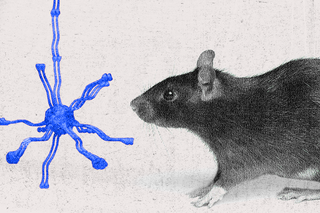
Human Neurons Were Transplanted Into Rats to Study Brain Disorders. Is It Ethical?
Organoid research poses several challenges—from creating hybrids to the possibility of “mini-brains” gaining consciousness, say scientists.

In what’s being called “groundbreaking research”, scientists have managed to transplant human neurons into rat brains. A recent study, published in the journal Nature, found that when tiny human brain-like structures—called organoids—were integrated into rat brains, they were able to respond to environmental stimuli sensed by the rats’ whiskers and send signals. Researchers say this could have a momentous impact on how scientists study brain disorders, by making it possible to examine how human neurons make connections in a developing brain.
On the other hand, researchers have posed some significant ethical questions that arise: Are we possibly creating rodent-human hybrids that could harm the animals? Could these animals develop ‘human’ characteristics? Can organoids gain consciousness?
Lab-grown “mini-brains” have been quite the rage in neuroscientific research, especially in the last decade. Scientists say that brain organoids, grown from human stem cells, offer immense possibilities in studying and developing therapies for neurological and psychiatric disorders. However, some researchers remain worried that the creation of organoids could be crossing lines of human experimentation.
This recent study adds to a rapidly developing field of research that seems to be critical in understanding the brain’s functioning. So far, a persisting problem is that organoids grown in labs can’t survive too long and may behave differently to neurons in the brain. This is because they neither develop blood vessels that could supply necessary nutrients, nor receive the sensory stimulation required for the brain to grow fully.
Transplanting them into rats’ brains could address these problems. When neuroscientist Sergiu Pasca and his colleagues grew organoids from human stem cells in the lab, it was to test this hypothesis, by observing if human neurons would integrate well with animal tissue when transplanted into rat brains.
The scientists hoped that the human cells would grow along with the rat cells. The procedure worked. When the rat brains were examined after six months, the researchers found that the human cells had integrated successfully with the animal tissue, growing to occupy one-third of a rat brain’s hemisphere.
The method allowed scientists to understand more about Timothy syndrome, a genetic condition with some symptoms similar to autism and epilepsy. The team created organoids from stem cells of people with Timothy syndrome. When transplanted into rat brains, the Timothy syndrome neurons were much smaller and did not develop dendrites (responsible for transmitting information to nearby neurons) in the same way as healthy neurons.
“We’ve learned a lot about Timothy syndrome by studying organoids kept in a dish,” said Pasca, who is a professor of psychiatry and behavioral sciences at the Stanford School of Medicine, and the study’s senior author. “But only with transplantation were we able to see these neuronal-activity-related differences.” The research findings could help study other conditions, from schizophrenia, bipolar disorder and autism to Alzheimer’s, Parkinson’s and eye conditions. It could also help analyze the effects of drugs that may address these conditions, all in real time. Organoids have already been used to probe how the Zika virus can lead to babies developing smaller brains.
In the present experiment, the organoids grew to closely resemble the human cerebral cortex, which is the outermost layer of the brain. They were then injected into the brains of newborn rats. Pasca explained that using adult rats for the procedure would not have been as successful as brain connections are mostly forged in the early stages of development.
The organoids were introduced into the same brain region for all rats—the somatosensory cerebral cortex, which receives signals from the rats’ sensory organs, including whiskers.
Related on The Swaddle:
Scientists Warn Mini‑Brains Used in Lab Research May Be Able to Feel
“We can now study healthy brain development as well as brain disorders understood to take root in development in unprecedented detail, without needing to excise tissue from a human brain… We can also use this new platform to test new drugs and gene therapies for neuropsychiatric disorders,” said Pasca.
The researchers also found that when they disturbed the rats’ whiskers, the implanted human cells fired in response to the sensory stimuli. Their study further showed that the implanted organoids could help drive the rats’ behavior. The team did this by genetically engineering human neurons to respond to a light stimulus from a fiber-optic cable that was inserted in the rats’ brains. They then trained the rats such that the animals would expect to receive water from a spout if the light is switched on. They proceeded to then shine a light on the hybrid brains, to which the rats responded by licking the spout, as they were trained to do.
In the words of Pasca, this might well be “the most advanced human brain circuitry” built in a lab. Researchers not part of the study have also heralded the work as “exciting”. In a Nature article, Rusty Gage, a neuroscientist at the Salk Institute for Biological Studies was quoted as saying, “We’ve got challenges out there for us… But I do believe the transplantation procedure will be a valuable tool.” In 2018, Gage and his team had shown that human brain organoids could be transplanted into adult mice.
Related on The Swaddle:
Japan Approves Research to Grow, Harvest Human Organs from Animal Embryos
Meanwhile, others have raised concerns of an ethical nature. Neuroscientists had previously warned researchers that they were “perilously close” to crossing ethical boundaries in organoid research. Ahead of a 2019 Society for Neuroscience conference, Elan Ohayon, director of the Green Neuroscience Laboratory in San Diego told The Guardian, “If there’s even a possibility of the organoid being sentient, we could be crossing that line… We don’t want people doing research where there is potential for something to suffer.”
In 2018,Hank Greely, who is the director of Stanford University’s Center for Law and the Biosciences, and an adviser on the recent study, called for an ethical debate along with a group of scientists, ethicists, lawyers and philosophers. “What if the organoid has some kind of consciousness and it suffers as a result of the transplant? Or what if the transplanted animal takes on “human” characteristics?… “It is not too early to think about how we could try to determine ‘society’s’ answer, if that day arrives,” he told The Guardian.
Another question that has been raised by ethicists is: If organoids can respond to light stimuli, can they also experience pain? A report by The US National Academies of Sciences, Engineering, and Medicine concluded it to be “extremely unlikely”. Human brain organoids had not yet reached a level of complexity to become conscious or require further legal regulation of such research. However,the report recognized how using human neural cells in animals could possibly blur the “distinction between humans and other animals” as a key ethical concern. It also stated that there is little evidence of the possibility of animals acquiring atypical behaviors, such as problem solving or complex social interactions. Still, it underlined that this area of research needs to be surveyed regularly to see if new developments require us to revisit these questions.
Studying the brain is a highly complex undertaking. The transplantation of organoids into animal brains, as scientists say, can be critical in providing a live example of how the brain makes connections. However, the concerns that accompany this discovery speak to the controversial nature of organoid research, spurring the debate around ethics in science. As Gage told The Guardian in 2019, “I think it is never too soon to raise issues about ethics in science, so that a thoughtful dialogue can guide scientific research and decisions.”
Ananya Singh is a Senior Staff Writer at TheSwaddle. She has previously worked as a journalist, researcher and copy editor. Her work explores the intersection of environment, gender and health, with a focus on social and climate justice.
Related


Giving Legal Rights to Animals, Trees Is Essential to Tackling Climate Crisis, Says Report
